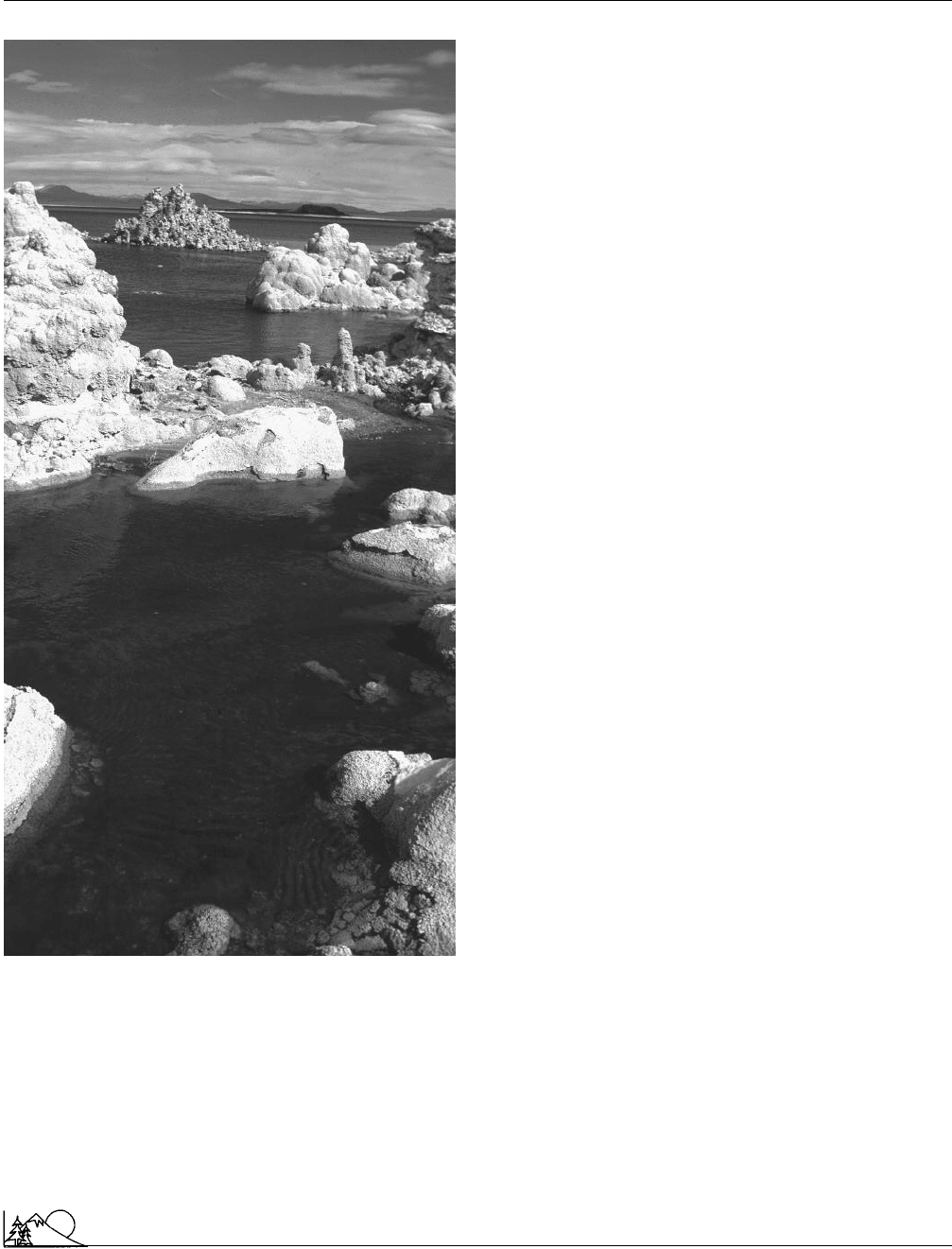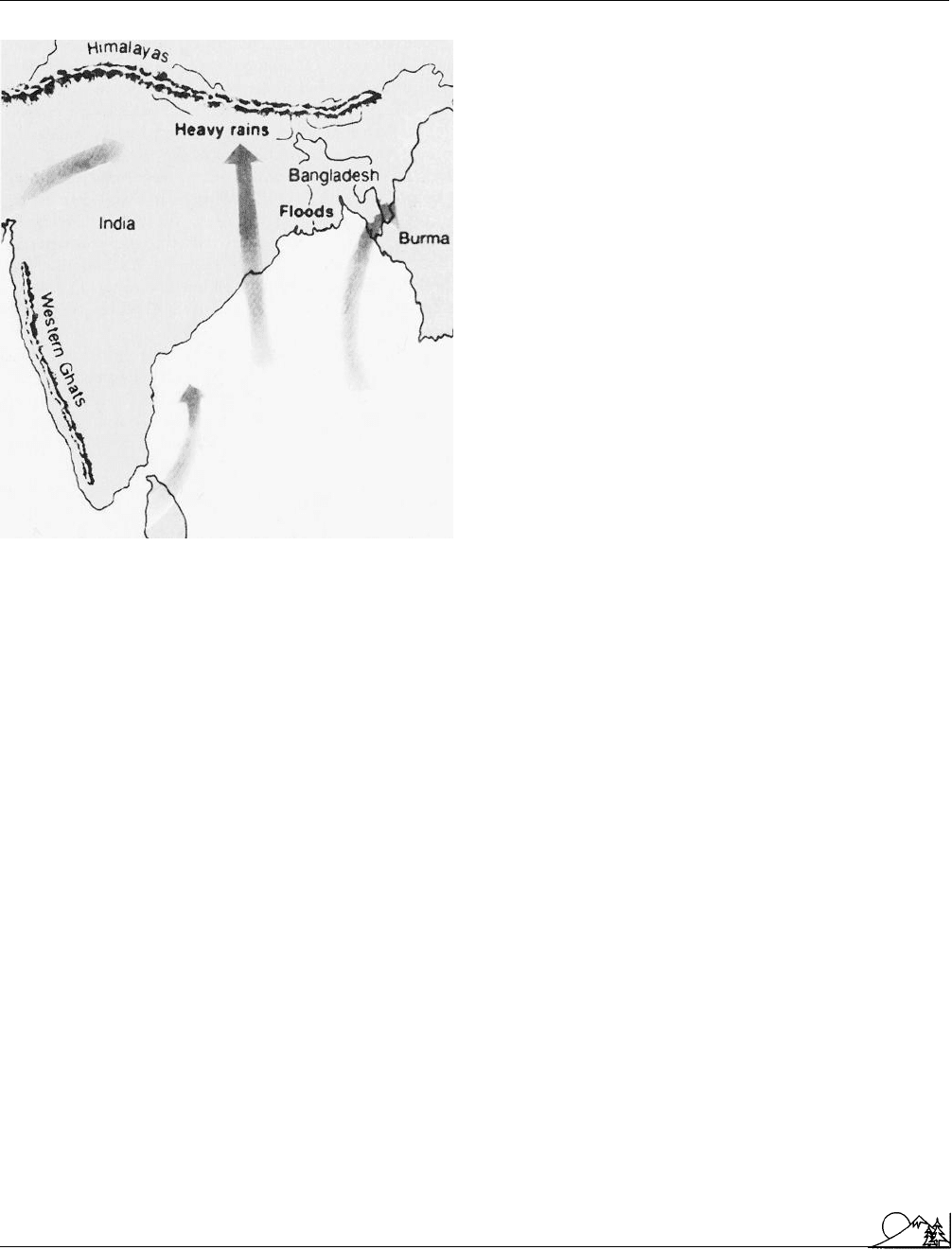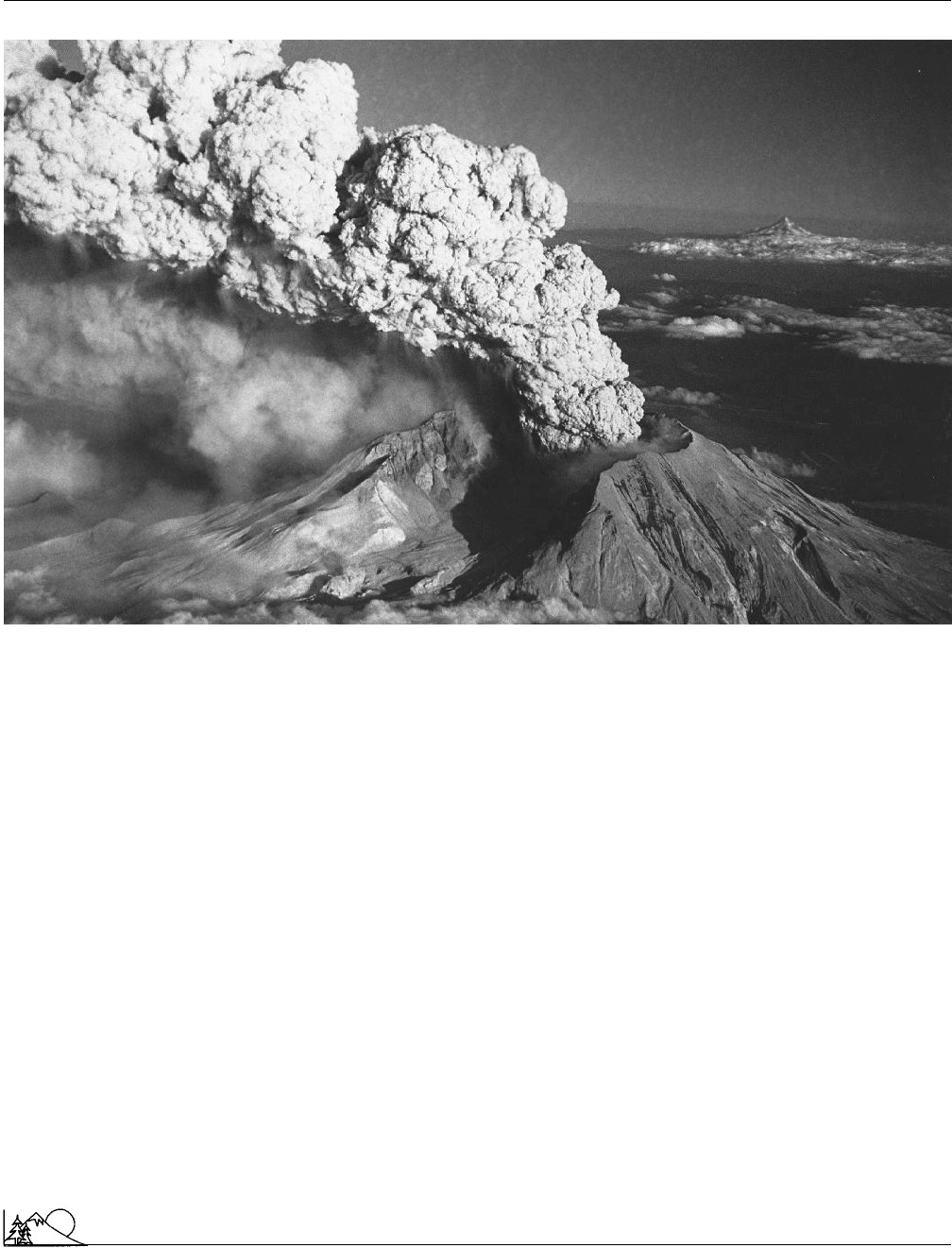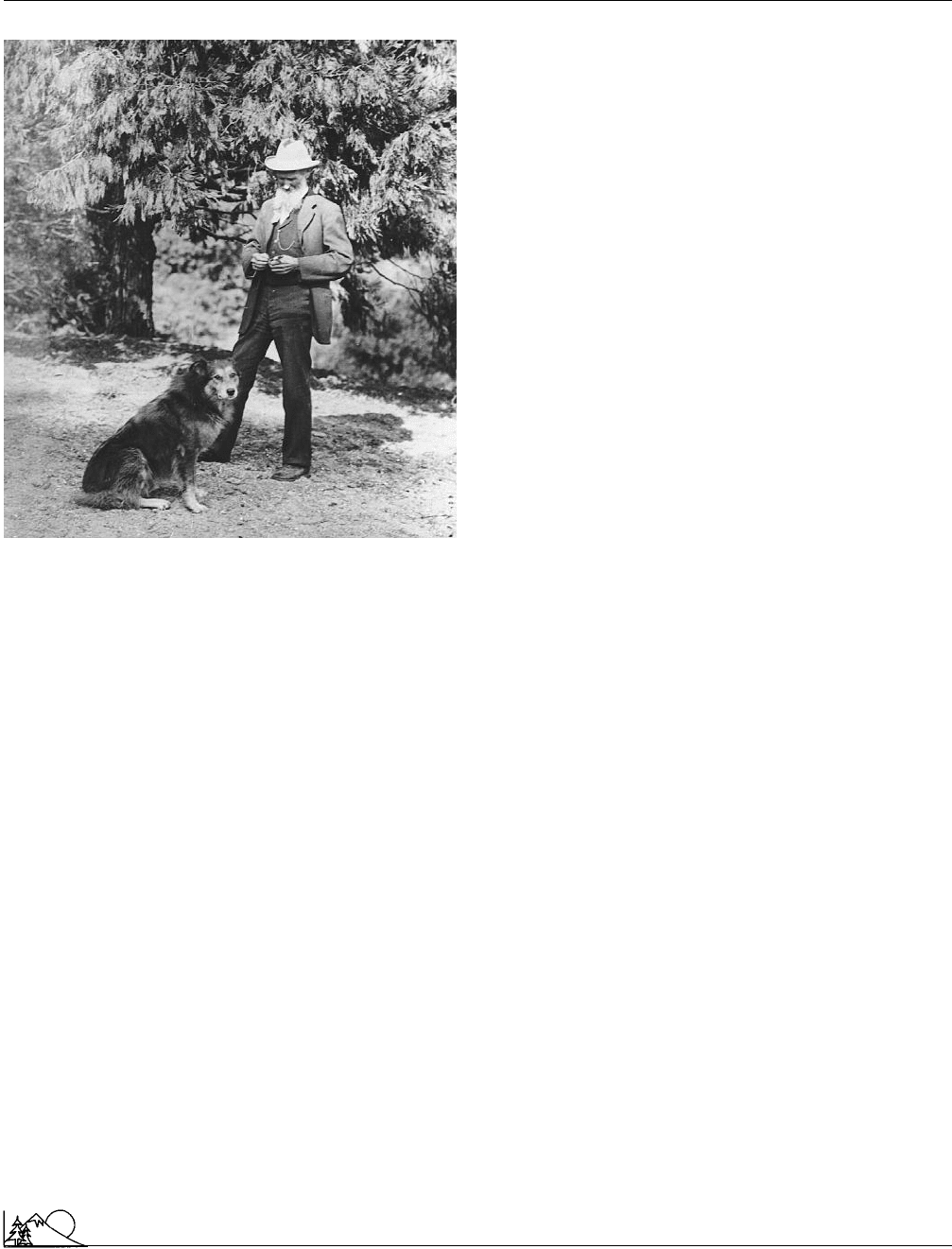Environmental Encyclopedia
Подождите немного. Документ загружается.


Environmental Encyclopedia 3
Monsoon
A view of frost covered rocks in Mono Lake,
California. (Photograph by R. Rowan. Photo Researchers
Inc. Reproduced by permission.)
the United States Congress established the Mono Basin
National Forest
Scenic Area.
Ultimately, the demand for water by Los Angeles
clashed with the demands of environmental groups, who
sought to maintain Mono Lake’s
ecological integrity
and
917
the fish habitat of streams feeding the lake. Lawsuits have
been fought in state and federal courts, and in 1989 Califor-
nia’s State Supreme Court ordered the Los Angeles Depart-
ment of Water and Power (LADWP) to reduce the amount
of water it was diverting from the lake. In 1993, the State
Water Resources
Control Board recommended that the
diversion be cut again, this time by half. LADWP has dis-
agreed, arguing that Los Angeles needs the water and that
the reduction is neither ecologically necessary nor economi-
cally wise.
The war over eastern Sierra water began at the turn
of the twentieth century, when Los Angeles acquired rights
to water previously used by farmers and ranchers in the
Owens Valley, just south of Mono Lake. By mid–century
the battleground had spread north to Mono Basin, and the
war promises to continue well into the next century. See
also Drinking-water supply; Hydrologic cycle; Los Angeles
Basin; National forest; Water allocation; Water resources;
Water rights
[Ronald D. Taskey]
R
ESOURCES
B
OOKS
Lane, P. H., and A. Rossmann. “Owens Valley Groundwater Conflict.”
In Deepest Valley, edited by Genny Smith. Los Altos, CA: William Kauf-
mann, 1978.
Patten, D. T. The Mono Basin Ecosystem. Washington, DC: National Acad-
emy Press, 1987.
Monoculture
The agricultural practice of planting only one or two crops
over large areas. In the United States, corn and soybean are
the only crops grown on most farms in the central Midwest,
while on the Great Plains wheat is almost exclusively grown.
Although it minimizes farmers’ investments in large, expen-
sive implements, the practice exposes crops to the risk of
being wiped out by a single predator. This happened with
the Irish potato blight of the 1840s and the corn leaf blight
of 1970 in the United States, which destroyed millions of
acres of corn. Ecologists warn against monoculture’s over-
simplification of the
food chain/web
, arguing that complex
webs are more stable.
Monsoon
Monsoon (from Arabic, mausim, season) technically means
a reversal of winds, that point between the dry and the wet
seasons in tropical and subtropical India, Southeast Asia,
and parts of Africa and
Australia
, when seasonal winds
change their direction. When the land heats up, the hot air

Environmental Encyclopedia 3
Montreal Protocol on Substances That Deplete the Ozone Layer
Each summer, warming air rises over the plains
of central India, creating a low-pressure cell
that draws in warm, moisture-laden air from
the ocean. Rising over the Western Ghats or the
Himalayas, the air cools causing heavy mon-
soon rains. (McGraw-Hill Inc. Reproduced by per-
mission.)
rises, causing a low pressure zone that sucks in moisture-
filled cooler ocean air, creating clouds and producing rain.
In winter, the opposite happens: warm air over the ocean
rises and makes a low pressure zone that draws the cooler
air off the land.
Although monsoon winds have always been watched
by traders and sailors in the Eastern Hemisphere, their arrival
is critical to millions of people who depend on agriculture.
Cultural and religious customs, especially in India and south-
east Asia, are tied to the monsoon rains that bring a season
of fertility after a long hot and sterile dry period.
Coastal radar and satellites aid in weather prediction,
but the climatological components of monsoons are complex.
Tied to the heat and moisture exchange between land and
oceans, their effect can be altered by changes in the circula-
tion of hemispheric winds at the equator, as well as by
precessional changes in the orbit of the earth.
Environmental changes such as
deforestation
or
soil
erosion
can invite severe
flooding
, as in Bangladesh during
the 1980s. Scientists believe a rise in sea surface temperature
in the Atlantic Ocean, possibly related to the
greenhouse
918
effect
, prevented the monsoon rain from reaching the Afri-
can
Sahel
and contributed to recent droughts. This ocean
temperature rise may also be tied to the
El Nin
˜
o
event in
the Pacific Ocean.
Any fluctuations in monsoon rain patterns can cause
disease and death, along with millions of dollars in damage.
If the rains are delayed, or never come, or fall too heavily in
the beginning or at the end of the growing season, disastrous
results often follow. See also Climate; Cloud chemistry; Me-
teorology
Montreal Protocol on Substances That
Deplete the Ozone Layer (1987)
A historical agreement made in 1987 by members of the
United Nations to phase out substances that are harmful to
the earth’s
ozone
layer. The ozone layer protects life on
earth by blocking out the sun’s harmful
ultraviolet radia-
tion
. Since the 1970s scientists have documented the deple-
tion of the ozone by
chlorofluorocarbons
(CFCs), com-
monly used for refrigeration and as solvents and
aerosol
propellants
. Alarmed by this growing global trend, scien-
tists and policymakers urged a decrease in the use and pro-
duction of CFCs as well as other ozone-damaging
chemi-
cals
. Ratifying the 1987 Montreal Protocol was a difficult
process, however, with the European Community, the for-
mer Soviet Union, and Japan reluctant to pose strict controls
on chemicals reduction. United States, Canada, Norway,
and Sweden, among others, favored stronger control and
negotiated with these nations to cut back and eventually
phase out completely ozone-depleting substances.
An amendment of the Montreal Protocol was made
in 1990 by 93 nations, including China and India, who had
not previously participated, to eliminate the use of CFCs,
carbon
tetrachloride, and halon gases by the year 2000 and
eliminate the production of methyl chloroform by 2005.
Some countries, like the United States, accelerated the
schedule to 1995. This 1990 amendment also established the
“Montreal Protocol Multilateral Fund” to help developing
countries become less dependent on ozone-depleting chem-
icals.
In November 1992 delegates from all over the world
met again in Copenhagen, Denmark, to further revise the
Montreal Protocol and accelerate the phase-out of ozone-
damaging substances and regulate three additional chemi-
cals. Some of those provisions were as follows: phase out
production of CFCs and carbon tetrachloride by 1996; ban
halons
by 1994 (the production of halogen was ended in
1994 in most industrialized nations and is expected to be
halted in China, Korea, India, and the former Soviet Union
by 2010); end production of methyl chloroform by 1996;

Environmental Encyclopedia 3
Mount Pinatubo
control the use of hydrochloroflurocarbons (HCFCs) and
eliminate them by 2030; and increase funding for the Multi-
lateral Fund (between $340 and $500 million by 1996).
Since the Copenhagen Amendments there have been
other amendments, such as the Montreal Amendment of
1997, which according to the Journal of Environmental
Law & Policy “adjusted the timetable for phaseout of some
substances and modified trade restrictions, including the
creation of a licensing system to attempt to decrease the
black market in ozone depleting substances;” and the Beijing
Amendment in 2002, which closely monitors bromochloro-
methane and the trade of hydrochloroflurocarbons.
As of July 2002, 175 nations have ratified the Montreal
Protocol. However, while countries have volunteered to con-
trol ozone-damaging chemicals, individual companies can
still produce the banned chemicals for “essential uses and
for servicing certain existing equipment.” The Alliance for
Responsible CFC Policy in Arlington, Vermont, praised
the concession for balancing environmental and economic
concerns. Others, such as members of the
Friends of the
Earth
, decry the provision as a “big loophole” that under-
mines the initiative of the Montreal Protocol. See also Ozone
layer depletion
[Kyung-Sun Lim]
R
ESOURCES
P
ERIODICALS
Benedick, R.E. “Ozone Diplomacy.” Issues in Science and Technology 6 (Fall
1989): 43–50.
DeSombre, Elizabeth R. “The Experience of the Montreal Protocol: Partic-
ularly Remarkable, and Remarkably Particular.” UCLA Journal of Environ-
mental Law & Policy 19, no. 1 (Summer 2001): 49.
“EU/UN: Change to Montreal Protocol Outlawing HCFCS due to Enter
into Force.” European Report (January 9, 2002): 515.
“Ozone-Protection Treaty Strengthened.” Science News 142 (December 12,
1992): 415.
More developed country
The terms more developed countries (MDCs) and
less de-
veloped countries
(LDC) were coined by economists to
classify the world’s 183 countries on the basis of economic
development (average annual per capita income and gross
national product). The 33 countries (including the United
States, Canada, Japan,
Australia
, New Zealand and all the
western European countries) in the MDC group are wealthy
and industrially-developed. They tend to have temperate
climates and fertile soils. About 23 percent of the world’s
population live in MDCs, but they consume about 80 percent
of its mineral and energy resources. In contrast the LDCs
are poorer and less industrially-developed. They tend to be
located in the Southern Hemisphere where the
climate
is
919
less favorable and soils are generally less fertile. Though the
boundaries are purposely vague, this dichotomy is useful for
contrasting the economic and social welfare of the richer
and poorer countries and in critical environmental categories
involving mainly demographic, economic, and social
statis-
tics
. See also Environmental economics; First World; Third
World
[Nathan H. Meleen]
R
ESOURCES
P
ERIODICALS
Ehrlich, P. R., and A. H. Ehrlich. “Growing, Growing, Gone (Rich Nations
Must Recognize Their Responsibility to Aid Overpopulated Third World).”
Sierra 75 (March-April 1990): 36–40.
Preston, S. H. “Population Growth and Economic Development.” Environ-
ment (March 1986): 6–9+.
Mortality
A measure of the death rate in a biological population,
usually presented in terms of the number of deaths per
hundred or per thousand. If there are 100 mice at the begin-
ning of the year and fifteen of them die by the end of the
year, the group’s mortality rate is fifteen per 100 individuals
(the initial population), or 15 percent. In ecological and
demographic studies of populations mortality is an important
measurement, along with birth rates (natality), immigration,
and emigration, used to assess changes in population size
over time. In human populations mortality rates are often
figured for specific age and gender groups, or for other
population categories including race, income level, occupa-
tion, and so on. This way group mortality rates can be
compared and risks for each subgroup can be evaluated. See
also Evolution; Extinction; Population growth; Zero popula-
tion growth
Mount Pinatubo
Mount Pinatubo in the Philippines erupted on June 15,
1991. When the 5,770-ft (1760 m) mountain shot
sulfur
dioxide
25 mi (40 km) into the
atmosphere
, the cloud
mixed with water vapor and circled the globe in 21 days,
temporarily offsetting the effects of global warming. Satellite
images taken of the area after the eruption showed a dustlike
smudge in the
stratosphere
. The sulfur dioxide cloud de-
flected 2% of the earth’s incoming sunlight and lowered
temperatures on worldwide average. Although the effects
on global temperatures were significant, they are thought to
be temporary. These light sulfur dioxides are expected to
remain in the stratosphere for years and contribute to damage
to the
ozone
layer.

Environmental Encyclopedia 3
Mount St. Helens
The Philippine islands originated as volcanoes built
up from the ocean floor. Most volcanoes erupt along plate
edges where ocean floors plunge under continents and melt-
ing rock rises to the surface as magma. The earth’s crust
pulls apart, creating gaps where the magma can rise. The
island of Luzon, where Mount Pinatubo is located, has
thirteen active volcanoes. The pattern of volcanoes around
the rim of the Pacific Ocean is called the Ring of Fire.
Mount Pinatubo sits in the center of a 3-mi (5-km)
wide caldera, a depression from an earlier eruption that made
the
volcano
collapse in on itself. A new cone formed over
time, and geothermal vents gave a clue that the volcano
was active. Before the 1991 eruption, Mount Pinatubo last
erupted 600 years ago. In April 1991 steam eruptions, earth-
quakes, increasing sulfur dioxide emissions, and rapid growth
of a lava dome all indicated a powerful impending blast.
Minor explosions began on the mountain on June 12, 1991.
This major eruption occurred in a country with an
already shaky economy, and the human effects are likely to
be significant for a long period of time. A total of 42,000
homes and 100,000 acres (40,500 ha) of crops were de-
stroyed. Nine hundred people died and 200,000 were relo-
cated, with 20,000 people remaining in tent cities. More
than 500 of those have died from disease and exposure.
The country suffered over $1 billion in economic losses.
Nevertheless, many lives were saved as a consequence of
scientists’ predictions of the eruption.
The destruction from Mount Pinatubo came mostly
from lahars, rushs of cementlike mud, formed when heavy
rains loosened the tons of ash dumped on the mountain’s
sides. These lahars can bury towns and roads and virtually
anything else in the way. Also deadly were the pyroclastic
flows, killer clouds of hot gases, pumice, and ash that traveled
up to 80 mi (130 km) per hour across the countryside, up
to 11 mi (18 km) away from the volcano. See also Geothermal
energy; Greenhouse effect; Ozone layer depletion; Plate tec-
tonics
[Linda Rehkopf]
R
ESOURCES
P
ERIODICALS
Berreby, D. “Acid-Flecked Candy-Colored Sunscreen.” Discover 13 (Janu-
ary 1992): 44–46.
Brasseur, G. “Mount Pinatubo Aerosols, Chlorofluorocarbons, and Ozone
Depletion.” Science 257 (28 August 1992): 1239–42.
Grove, N. “Volcanoes: Crucibles of Creation.” National Geographic 182
(December 1992): 5–41.
Kerr, R. A. “Pinatubo Global Cooling on Target.” Science 259 (January 29,
1993): 594.
Monastersky, R. “Pinatubo Deepens the Antarctic Ozone Hole.” Science
News 142 (October 24, 1992): 278–79.
920
Mount St. Helens
On May 18, 1980, Mount St. Helens exploded with a force
comparable to 500 Hiroshima-sized atom bombs. David
Johnston, a United States
Geological Survey
(USGS) geol-
ogist based at a monitoring station six miles (9.7 km) away
announced the eruption with his final words, “Vancouver,
Vancouver, this is it.” Dramatic photograph’s provided the
public with an awesome display of nature’s power.
Mount St. Helens, in southwestern Washington near
Portland, Oregon, is part of the Cascade Range, a chain
of subduction volcanoes running from northern California
through Washington. The Mount St. Helens eruption was
instrumental in the expansion of the USGS
Volcano
Haz-
ards Program. Research at the new Cascades Volcano Obser-
vatory in Vancouver, Washington, has strengthened basic
understanding of volcanic processes and the ability to predict
eruptions. Highly relevant ecological studies have corrected
previous errors and misconceptions, leading to a new theory
about nature’s ability to recover after such events.
Research has heightened public awareness of the in-
herent instability of high, snow-covered volcanoes, where
even small eruptions can almost instantaneously melt large
volumes of snow. A relatively small 1985 eruption at Nevado
del Ruiz in central Colombia killed more than 23,000 people.
The Mount St. Helens blast and subsequent collapse gener-
ated a 0.7 cubic mile (2.8 km
3
) mud flow which raced 22
miles (35 km) at speeds as high as 157 mph (253 kph).
This caused massive problems, even halting traffic on the
Columbia River. These flows may also create unstable
dams
,
which may burst years after the intial eruption.
In addition to its awesome power and destructive force,
the Mount St. Helens eruption has provided rich material
for research. Conductivity studies have located a large rotat-
ing block under Mounts Rainier, Adams, and St. Helens, the
friction from which is a likely source of eruptions. Geologic
mapping and historical research, coupled with field studies
of current volcanism, have corrected misconceptions and
given clues to hazard frequency. Studies of nature’s recovery
efforts have produced surprises, notably the early arrival in
the eruption zone of predatory insects; elk grazing in open,
reforested areas; and the explosive growth of uncommon,
dangerous bacteria due to the high temperatures generated
by the eruption. Biological legacy has emerged as the unifying
theory describing nature’s recovery capabilities, an idea with
direct applications to forestry practices and
reclamation
of human-disturbed land. Nature’s mess provides valuable
nutrients and nurseries; furthermore, old growth areas within
managed ecosystems nurture the recovery of
biodiversity
.
Mount St. Helens has provided a unique laboratory
for study of volcano hazards and nature’s ability to recover

Environmental Encyclopedia 3
John Muir
Mount St. Helens erupting with Mt. Hood in the background. (UPI/Corbis-Bettmann Newsphotos. Reproduced by permission.)
from the devastation caused by volcanic eruptions. See also
Mount Pinatubo, Philippines; Reclamation; Topography
[Nathan H. Meleen]
R
ESOURCES
B
OOKS
Bilderback, D. E., ed. Mount St. Helens, 1980: Botanical Consequences of
the Explosive Eruptions. Berkeley: University of California Press, 1987.
P
ERIODICALS
Decker, R., and B. Decker. “Eruption of Mount St. Helens.” Scientific
American 244 (March 1981): 68–80.
O
THER
Tilling, R. I., L. J. Topinka, and D. A. Swanson. Eruptions of Mount
St. Helens: Past, Present, and Future. USGS General Interest Publication.
Washington, DC: U. S. Government Printing Office, 1990.
Wright, T. L., and T. C. Pierson. Living With Volcanoes: The USGS Volcano
Hazards Program. USGS Circular 1073. Washington, DC: U. S. Govern-
ment Printing Office, 1992.
MTBE
see
Methyl tertiary butyl ether
921
John Muir (1838 – 1914)
American naturalist and writer
John Muir is considered one of the towering giants of the
conservation/environmental movement in the United States.
Anyone seriously interested in natural history,
conserva-
tion
,
wilderness
preservation, or the national parks in this
country should be aware of John Muir’s work. He was a
spirited, joyous naturalist, a serious student of glaciers, an
influential advocate of wilderness preservation, and the ac-
knowledged founder of the
national park
idea. Born in
Dunbar, Scotland, Muir emigrated with his family to the
United States in 1849 when he was 11 years old. He spent
his youth working on a farm in the Wisconsin wilderness,
trying to please his father, who was a deeply religious man.
The wilderness, his religious background, and the hard labor
influenced his thinking the rest of his life.
Muir’s father believed the Bible to be the only book
necessary for a young person, but Muir managed to educate
himself and to spend several years at the University of Wis-
consin (where he chose his own curriculum and so left with-
out a degree). After school, he worked at various jobs, gener-

Environmental Encyclopedia 3
John Muir
ally quite successfully, until a factory accident temporarily
blinded him. He vowed that if his sight returned, he would
leave the factory and see as much of the world as possible.
After about a month, his sight did return and he left for
various jaunts in the wilderness, including a famous 1,000-
mi (1,609 km) walk through the country to the Gulf of
Mexico, an account recorded in A Thousand Mile Walk to
the Gulf (1916).
His eventual goal was to reach South America and
wander through the Amazonian tropical rain forests. He
reached Cuba, but a bout with fever (carried over from the
humid lowlands of Florida) turned him instead toward the
drier West, especially California and the Yosemite Valley,
about which he had seen a brochure and which he deter-
mined to see for himself. “Seeing for himself” also became
a life-time habit, and he eventually traveled over much of
the world. As he had planned, he did make it up the Amazon,
in 1911, at the age of 73.
Arriving in California in 1868, he made his way to
Yosemite and spent several years studying its landforms,
wildlife
, and waterways, earning his living by herding sheep,
working in a sawmill, and other odd jobs. As Edward Hoag-
land noted, Muir “lived to hike,” a mode of
transportation
that involved him intimately in the landscape. He traveled
light, and alone, often with little more than some dry bread
in a sack, tea in a pocket, a few matches and a tin cup, and
perhaps a plant press.
Through his travels in Yosemite, he became convinced
that the spectacular land forms of Yosemite had been carved
by glaciers or, as he put it, “nature chose for a tool...the
tender snow-flowers noiselessly falling through unnumbered
centuries.” His belief in glacial origins placed him in conflict
with the established scientific ideas of the time, especially
those held by the California state geologist. But Muir even-
tually prevailed, his ideas vindicated when he found the first
known glacier in the Sierra range. The results of his years
of intense glacial investigations are available in Studies in
the Sierra (1950). Current views have verified his theories,
changing only the number of glacial events and emphasizing
the role of water in cutting the canyons. Muir also made
five trips to Alaska to study glaciers there, one of which is
named for him.
His glacial studies were the principle contributions
Muir made as an original scientist, most of his life being
devoted to travel, writing, and conservation activism. Even
as early as 1868, Muir was concerned with the effects sheeph-
erding had on plant life and
soil erosion
.
Muir’s travels were interrupted for a time when, in
early 1880, he married Louise Strentzel, the daughter of a
fruit rancher in the Alhambra valley. Muir helped run the
ranch, first rented and then bought some of the acreage,
applying his inventiveness and hard work to fruit growing.
922
Reportedly, he was a good businessman, prospering after
only a decade to ensure a measure of financial independence.
He then sold part of the ranch and leased the rest, which
allowed him time with his daughters, to return to his beloved
wilderness, and to write and actively promote his wilderness
ideas. Muir’s intimate acquaintance with the Yosemite area
and the Sierra Nevada exposed him not only to the depreda-
tions of sheep but also to the rapid felling of giant old
Sequoias, cut up for shingles and grape stakes. Muir’s re-
sponse: “As well sell the rain clouds, and the snow, and the
river, to be cut up and carried away....” In 1889, he escorted
the editor of Century magazine to Yosemite and showed
him the negative impacts of sheep, which he called “hoofed
locusts.” A series of articles in that magazine alerted the
public to the destruction of the land, and they eventually
pressured Congress to establish the Yosemite area a national
park in 1890.
An earlier attempt to rally interest in the plight of the
western forests—a suggestion for a government commission
to survey the forests and recommend conservation mea-
sures—was also realized with the appointment of such a
commission in 1896. Charles Sargent, the chair of the com-
mission, invited Muir to participate and, on the basis of the
Sargent Commission’s recommendation, President Grover
Cleveland created thirteen forest preserves, setting aside 21
million acres. Negative reaction from commercial interests,
however, nullified most of these gains. Muir responded by
writing two articles on forest reserves and parks in Harper’s
Weekly and Atlantic Monthly in 1897. These articles helped
to rally public support and in 1898, the annulments were
reversed by Congress.
Muir influenced the public and extended his influence
by friendships and correspondence with some of the most
powerful people of his time. A number of the successes
of the early conservation movement, for example, can be
attributed to his influence on such figures as
Theodore
Roosevelt
. After a three-day camping trip with Muir under
the Big Trees in 1903, Roosevelt added many millions more
acres to the
national forest
system, as well as national
monuments and national parks and created what became
the
national wildlife refuge
system.
Known for his many successes, Muir was much sad-
dened by his one big loss: the damming of Hetch Hetchy
valley in
Yosemite National Park
as a
reservoir
to supply
water to San Francisco. Muir’s public image was damaged
by the excessive vehemence of his attacks upon the citizens
of San Francisco, whom he denounced as “satanic,” and
following the Hetch Hetchy incident, Muir retired to his
ranch to edit his journals for publication.
Muir never considered himself much of a writer and
begrudged the time it took away from his beloved mountains
and forests. Most of his books were published late in life,

Environmental Encyclopedia 3
Multiple Use-Sustained Yield Act (1960)
John Muir and his dog. (Corbis-Bettmann. Repro-
duced by permission.)
after the turn of the century. His writings are still widely
read today by students, scholars, activists, and philosophers.
In the opinion of most observers, the primary importance
of Muir’s writings lies not in their literary quality but in the
fact that they persuaded a large number of Americans to
regard scenic wilderness areas as irreplaceable
natural re-
sources
which must be protected and preserved.
[Gerald L. Young Ph.D.]
R
ESOURCES
B
OOKS
Browning, P., ed. John Muir in His Own Words: A Book of Quotations.
Lafayette, CA: Great West Books, 1988.
Cohen, M. P. The Pathless Way: John Muir and the American Wilderness.
Madison: University of Wisconsin Press, 1984.
Fox, S. John Muir and His Legacy: The American Conservation Movement.
Madison: University of Wisconsin Press, 1985.
Turner, F. Rediscovering America: John Muir in His Time and Ours. New
York: Viking Penguin, 1985.
P
ERIODICALS
Hoagland, E. “In Praise of John Muir.” Anteus no. 52 (Spring 1984): 170–83.
Wadden, K. A. “John Muir and the Community of Nature.” The Pacific
Historian 19 (Summer–Fall 1985): 94–102.
923
Mulch
Material applied to the surface of a
soil
to protect the soil
or to improve the
environment
of the soil’s surface. Mulch
can be made from many different kinds of organic or inor-
ganic materials like stones, bark, compost, leaves, wood
chips, and manure. The benefits of using mulch include
the following: protection of soil from
erosion
, evaporation
reduction, increased water
infiltration
, reduction in weed
seed germination, increased seed germination, and reduction
of
compaction
of soil. See also Animal waste; Composting;
Fertilizer; Soil organic matter; Soil texture; Topsoil
Multiple chemical sensitivity
Regarded by skeptics as a manifestation of “technophobia”
and “chemophobia,” multiple chemical sensitivity is a highly
controversial disorder associated with low levels of environ-
mental
chemicals
in general and volatile organic chemicals
in particular. Sufferers experience fatigue, malaise, headache,
dizziness, lack of concentration, and loss of memory, and
are often so disabled that they cannot live or work except
in completely chemical-free environments. Critics argue that
this condition should not receive clinical recognition as a
disease, insisting that the condition has no uniform cause
or consistent, measurable features. Advocates for sufferers
say it is a chronic condition marked by heightened sensitivity
to even slight chemical exposures; and that multiple symp-
toms occur in multiple organ systems, usually caused by large
“triggering” exposures such as to new carpeting that emits
chemicals.
Multiple Use-Sustained Yield Act
(1960)
On June 12, 1960, Congress passed the Multiple Use-Sus-
tained Yield Act, designed to prevent the obliteration of
national forests by
logging
and
water reclamation
proj-
ects. This law officially mandated the management of na-
tional forests to “best meet the needs of the American peo-
ple.” The forests were to be used not primarily for economic
gain, but for a balanced combination of “outdoor
recreation
,
range, timber,
watershed
, and
wildlife
and fish purposes.”
The Multiple Use Act emerged from a strong history
of diverse uses of the federal reserves. Early settlers assumed
access to and free use of public lands. The text of the Sundry
Civil Act of 1897 mandated that no public forest reservation
was to be established except to improve and protect forests
and water flow. The act also provided for free use of timber
and stone and of all reservation waters by miners and resi-

Environmental Encyclopedia 3
Multi-species management
dents. The Act of February 28, 1899, strengthened use policy
by providing for recreational use of the reserves.
When the reserves were transferred from the General
Land Office to the Bureau of Forestry, the Secretary of
Agriculture signed a letter (actually written by
Gifford Pin-
chot
) dictating formal forest policy: “all the resources of the
forest reserves are for use... you will see to it that the water,
wood, and forage of the reserves are conserved and wisely
used.” The first and subsequent editions of the Use Book—
an extensive guide to management and use of
national
forest
lands—stated concisely that the aim of
Forest Service
policy was that “the timber, water, pasture, mineral and other
resources of the forest reserves are for the use of the people.”
The first use of the term “multiple use” appears to be
in two Forest Service reports of 1933. That year’s chief’s
report reaffirmed that the “principle to govern the use of
land...is multiple-purpose use.” The “National Plan for
American Forestry” (the Copeland Report) emphasized that
“the peculiar and highly important multiple use characteris-
tics of forest land [involve] five major uses--timber produc-
tion, watershed protection, recreation, production of forage,
and
conservation
of wildlife.”
Multiple use has always been controversial. Some crit-
ics argued that multiple uses meant that the Forest Service
was losing sight of its original protective function: a 1927
article in the Outlook claimed that “the Forest Service will
have to be called from its enthusiasm for entertaining visitors
to the original but more somber work of forestry.” Many
similar statements can be identified. A writer in the Journal
of Forestry in 1946 went so far as to propose separating all
the lands in each use class, consolidating each type into a
separate bureau under one cabinet officer. The
Sierra Club
proposed a vast land exchange in 1959, hoping to move
scenic areas out of the Forest Service and into the
U.S.
Department of the Interior
.
Critics have argued, and feel that subsequent policy
and events on the ground bear them out, that the Multiple
Use Act did not reduce confusion because it did not eliminate
water and timber as priority uses. Proponents of the act feel
that it did give statutory authority to all uses as equal to
timber and did give the other four uses more stature and
visibility
. See also Bureau of Land Management; Commer-
cial fishing; Public Lands Council
[Gerald L. Young Ph.D.]
R
ESOURCES
B
OOKS
Bowes, M. D., and J. V. Krutilla. Multiple-Use Management: The Economics
of Public Forestlands. Washington, DC: Resources for the Future, 1989.
Frederick, K. D., and R. A. Sedjo, eds. America’s Renewable Resources:
Historical Trends and Current Challenges. Washington, DC: Resources for
the Future, 1991.
924
Steen, H. K. “Multiple Use: The Greatest Good of the Greatest Number”
and “Multiple Use Tested: An Environmental Epilogue.” In The United
States Forest Service: A History. Seattle, WA: University of Washington
Press, 1976.
Multi-species management
Multi-species management (MSM) specifies the develop-
ment of a particular ecologically balanced assessment and
operation in protecting fish and
wildlife
. Such protection
of
species
and the
environment
that supports and sustains
them relies on understanding the species’ interaction with
each other, and within a particular environment—whether
a body of water, a marshland, or other natural surroundings.
The
Environmental Protection Agency
(EPA) and the
U.S.
Fish and Wildlife Service
(FWS) play key roles in
overseeing this management due to the imperative for restor-
ing and maintaining an effective
ecosystem
. In concert with
the Endangerd Species Act (ESA), the focus in MSM is
on lessening the possibility of certain species being added
to the Endangered Species list in addition to the management
of those species currently thriving.
In the fall of 2002, the College of Foresty at Oregon
State University was hosting a symposium, Innovations in
Species Conservation for the purpose of studying the issues
of strategies for conserving species, ecological risks and un-
certainties associated with certain strategies, and examining
social and legal contexts of
conservation
strategies. The
announcement for the symposium pointed out that, “In the
past, efforts to conserve species have focused on providing
appropriate
habitat
for, and population management of,
individual high-profile species protected by laws and regula-
tions. Some regional plans have been designed to conserve
a broad array of species and biological diversity by specifying
protection of rare and uncommon species.” But according
to the research indicated, there also remain some questions
regarding the multi-species direction. The discussion goes
on to say that, “Such approaches have proven to be complex
and expensive, and have placed constraints on the ability
to meet other important management objectives. Multiple-
species or ecosystem approaches addressing species assem-
blages at regional scales may be more efficient and lessen
management constraints, but the degree to which they pro-
tect individual species rests more on hypothesis than on
systematic testing. Such multi-system approaches may also
be more susceptible to legal challenges due to a lower level
of certainty regarding the outcomes for a particular species.”
Still, by 2002, evidence continues to emerge from ex-
tensive research over the last few decades, that MSM has
produced some results that indicate success. The theory is
that if one species, or aspect of an ecosystem is out of balance,
therefore the entire system is out of balance. In a 1999 article

Environmental Encyclopedia 3
Municipal solid waste
written by Dick Monroe, Vice President of Environmental
Affairs for Darden Restaurants, he noted that global man-
agement of
whales
and
seals
directly affected the seafood
and restaurant industry. It was his concern—in opposition
to the philosophy of many
animal rights
and whale watch
groups—that whales were consuming between three and six
times the total annual catch of all commercial fisheries. He
noted that an MSM approach must be supported because
when the focus is simply on one species, another is sure to
lose out and the supply depleted.
The Kyoto Treaty—the United States backed out of
support of the treaty under the George W. Bush administra-
tion in 2001—also specifies MSM as one of its components.
Throughout the United States, under the sponsorship of
various government and private agencies, MSM had become
an important research approach to environmental concerns.
It represents a worldwide effort as well as one for the United
States—especially in countries that rely heavily on the fishing
industry as a support of their economic system. In Norway,
for instance, in order to manage certain fishing stocks in the
Barents Sea, it was crucial for researchers to determine how
much of that species waaas eaten by another fish. The Insti-
tute of Marine Research in Bergen (Norway) developed a
multi-species model to address this issue, among others. In
managing the stock of capelin, it was crucial to know how
much of it was consumed by the cod, and also in marine
mammals. Beginning in 1987, Norwegian and Russian sci-
entists cooperated in collecting this information. By 1993,
the groups had collected samples from the stomach content
of over 50,000 cod. This example of the mechanism by which
MSM operates is typical of similar programs throughout the
United States, and around the world.
[Jane E. Spear]
R
ESOURCES
P
ERIODICALS
Gutting, Richard. “Action Needed to Avert Supply/Demand Gap.” Seafood
Industry (August 1996): 43.
Russell, Dick. “Hitting Bottom.&rdquo Amicus Journal February 3, 1997
[cited July 2002].
Valles, Colleen. “Panel Passes Restrictions on West Coast Fishing to Protect
Depleted Species.” Associated Press/Environmental News Network [cited June
21, 2002]. <http://www.enn.com/news>.
O
THER
Cardin, Ben. Testimony in Support of the Reauthorization of the Chesapeake
Bay Office of the National Oceanic and Atmospheric Administration HR 4789.
September 21, 2000 [cited July 2002]. <http://www.house.gov/ca>.
Chesapeake Bay Program. Chesapeake 2000 Agreement. [cited June 2002].
<http://www.chesapeake.org>.
Chesapeake Bay Program. Scientific and Technical Advisory Committee. [cited
June 2002]. <http://www.chesapeake.org/stac>.
Food and Agriculture Organization. Sustainable Contribution of Fisheries to
Food Security. [cited June 2002]. <http://www.fao.org/fi>.
925
IWMC (formerly International Wildlife Management Consortium). Envi-
ronment; What Do Whales have to do with Your Menu? September 25, 1999
[cited July 2002]. <http://www.iwmc.org>.
Norwegian-scenery. Norwegian Management of Marine Resources. [cited June
2002]. <http://www.norwegian-sceneery.com>.
Oregon State University, College of Forestry. Innovations in Species Conser-
vation. [cited June 2002]. <http://www.outreach.cof.orst.edu>.
Stefansson, Gunnar. “Management in the Multi-species Context.” Hafran-
nsoknastofnunin (Marine Research Institute). February 28, 2002 [July 2002].
<http://www.hafro.is>.
U.S. Fish and Wildlife Service. National Fish Hatchery System. [cited June
2002]. <http://www.fisheries.fws.gov>.
White, Ph.D., Michael D. The Lower Colorado River Multi-Species Conser-
vation Program. [cited June 2002]. <http://www.sci.sdsu.edu/salton>.
World Wildlife Fund. The Food-Web Effect. [cited June 2002]. <http://
www.panda.org/resources>.
O
RGANIZATIONS
U.S. Environmental Protection Agency, 1200 Pennsylvania Avenue, N.W.,
Washington, D.C. USA 20460 202-260-2090, www.epa.gov
U.S. Fish and Wildlife Service, Washington, D.C. USA, www.fws.gov
Municipal solid waste
Americans generate about 160 million tons of municipal
solid waste
(MSW) per year not counting construction
debris. That’s enough
garbage
to fill a convoy of trash
trucks reaching half way from the earth to the moon. That
much garbage equals about 1,300 pounds (590 kg) of waste
per year for every person in the United States, or about 25
pounds (11.5 kg) per person per week. The
Environmental
Protection Agency
(EPA) tells us that every year Americans
throw away 60 billion cans, 28 million bottles, 4 million
tons of plastic, 40 million tons of paper, 100 million tires,
and 3 million cars. If growth in disposal rates continue,
Americans may generate nearly 2,000 million tons of MSW
by the year 2000.
Municipal solid waste is waste generated by house-
holds, commercial businesses, institutions, light industry and
agricultural enterprises and nontoxic wastes from hospitals
and laboratories. Municipal waste is composed of (in order
of volume contribution) paper/packaging,
yard waste
,
food
waste
, magazines/newspapers,
plastics
, glass, wood/fabric,
disposable diapers
, and other contributions such as tires,
appliances, and nontoxic home maintenance supplies. In
addition to this relatively benign list, there is other municipal
waste that ends up in a
landfill
inappropriately—e.g., left-
over paint, crankcase oil, batteries, and parts of some appli-
ances such as capacitors in refrigerators and air conditioners.
In some cases sewage
sludge
from the local
wastewater
treatment facility ends up in the landfill with other municipal
solid waste. It is these inappropriate wastes that cause con-
cern in the minds of local officials as they ponder the siting
of landfills.

Environmental Encyclopedia 3
Municipal solid waste composting
Since municipal waste is a non-homogeneous stream
of materials, its impact is unpredictable. Although only about
two percent of the municipal
waste stream
is toxic, even
that small amount has the potential of contaminating large
amounts of
groundwater
if the leachate from landfills reach
the
aquifer
. In addition, landfills situated near a lake or a
stream can leak laterally and contaminate surface water. In
spite of the fact that the engineering of landfills has become
much more sophisticated in the last 10 years, there is still
sincere concern about the impact of municipal waste on
ground and surface water.
Several methods for managing municipal solid waste
have been designed and implemented over the last 20 years.
In the United States, 80% or more of the municipal solid
waste ends up in landfills, about 10% is incinerated, and
about 11% is recycled. Waste-to-energy
incineration
is an
option aimed at reducing the volume of municipal waste
and producing an ongoing supply of energy for nearby mar-
kets. The complication of this treatment method is the ash
residue and its disposal as well as
air pollution
. Probably
the most desirable management technique for MSW is
re-
cycling
.
Recycling captures the embodied energy in the prod-
ucts to be discarded. The conversion of the waste stream
into a second or third generation of usable products is far
superior to simple volume destruction or land burial. Unfor-
tunately, recycling requires behavioral change on the part of
the waste generator and behavioral and infrastructure change
on the part of industry in order to create markets for post
consumer materials. Individuals must learn to clean and
separate household garbage and make it ready for recycling.
Industry must make the investment to change manufacturing
processes to accommodate a heterogeneous “raw” material.
Even more desirable than recycling is source reduction
and
reuse
of household products and industrial and business
supplies. Buying durable and re-usable products reduces the
volume of the MSW stream. Packaging that can be reused
after the product has been used is another way of shrinking
municipal solid waste volume. In some European countries
like Germany, manufacturers are required to take back all
their packaging materials.
The cost of MSW disposal has increased dramatically
over the last 10 years. Part of this cost is due to the pressure
being put on fewer and fewer landfills as older landfills close.
Many metropolitan areas of the United States have exhausted
their landfill capacity and are transporting waste into rural
areas. Unfortunately, in rural areas the volume of MSW is
not sufficient for landfill companies to make the investment
and build state-of-the-art landfills. Furthermore there is
increasing concern that many towns and cities are dumping
their MSW in areas where people have less political power
or need the revenue from tipping fees. Consequently the
926
management of waste has become a social issue as well as
an environmental concern.
Currently there are approximately 3,500 licensed land-
fills operating in the United States. Tipping fees have in-
creased as have transport fees. States are transporting MSW
hundreds of miles to other states because they can’t build
landfills due to citizen opposition. The NIMBY (
Not In
My Backyard
) syndrome makes it difficult to create more
landfills.
Waste management
companies are offering ex-
tensive incentive packages to local communities in order to
get approval for landfill siting. Yet, almost without exception,
local citizens attempt to block the construction of landfills.
Municipal solid waste is a renewable resource. We will
always have new supplies of it. Even though many citizens
are beginning to turn to nondisposable items and there is a
real effort to launch recycling programs nationwide, we are
still faced with an increasing volume of municipal waste. It
is a complex problem that will require behavioral change on
the part of individuals, a commitment on the part of local
city planners, and an investment on the part of industry in
order to recycle the waste stream. See also Medical waste
[Cynthia Fridgen]
R
ESOURCES
B
OOKS
Blumberg, L., and R. Gottlieb. War on Waste: Can America Win Its Battle
with Garbage? Washington, DC: Island Press, 1989.
Rathje, W., and C. Cullen. Rubbish! The Archaelogy of Garbage. New York:
Harper-Collins Publishers, 1992.
The Solid Waste Dilemma: An Agenda for Action. Washington, DC: Environ-
mental Protection Agency, 1989.
Municipal solid waste composting
Municipal Solid Waste
(MSW) composting is a rapidly
growing method of solid
waste management
in the United
States. MSW includes the residential, commercial, and insti-
tutional
solid waste
generated within a community. MSW
composting
is the process by which the organic,
biode-
gradable
portion of MSW is microbiologically degraded
under
aerobic
conditions.
During the process of degradation, bacteria are used
to decompose and break down the organic matter into water
and
carbon dioxide
, which produces large amounts of heat
and water vapor in the process. Given sufficient oxygen and
optimum temperatures, the composting process achieves a
high degree of volume reduction and also generates a stable
